Advertising addresses with Multipath TCP
An important feature of Multipath TCP is that the communicating hosts can easily learn the addresses that can be used to reach their peers. Multipath TCP uses special TCP options to advertise this information. In this post, we look at the evolution of these options during the design of RFC 6824
The first MPTCP draft, draft-ford-mptcp-multiaddressed-00 defined four options to deal with addresses.
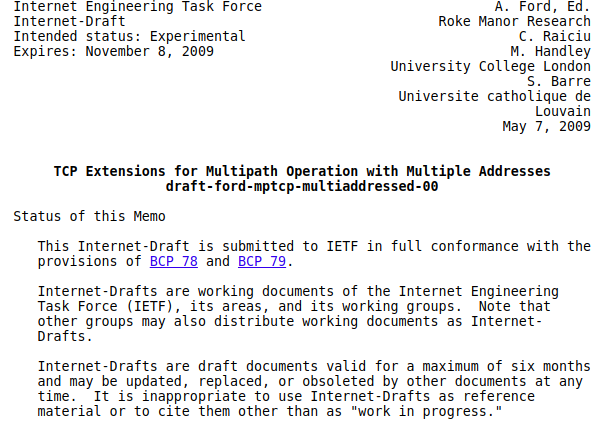
The first option was called Add Address. It was intended to advertise one IP address owned by the host that sends it over a given Multipath TCP connection. This option contained an IP version field, to support IPv4 and IPv6, and an index. This index was intended to cope with NAT that could translate addresses in the IP header without translating information in the TCP options.

A companion option was the remove address option that simply contained the index of the address to be removed.

In addition to these two options that have been slightly modified later in RFC 6824, draft-ford-mptcp-multiaddressed-00 also defined two options for implicit path management. The first one is Request-SYN. It was intended to request the peer to initiate a subflow towards the announced address. The Add Address option was intended to be purely informational and the Request-SYN was intended to trigger the establishment of a new subflow.
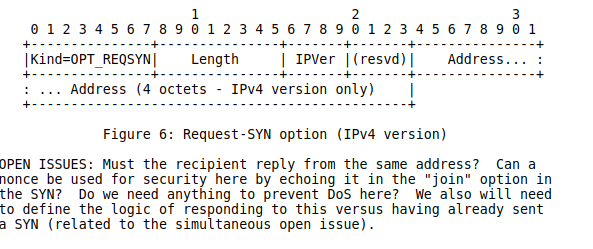
There was also a Request-FIN option that was intended to request the termination of a subflow.

These two options were removed in draft-ford-mptcp-multiaddressed-01 and only the Add and Remove address options were kept.
The working group draft, draft-ietf-mptcp-multiaddressed-00 introduced another two changes to these options. First, it became possible to advertise a specific port number together with an IP address. Second, the document included a discussion on adding a backup flag to indicate that the advertised address should be treated as a backup one. This bit became fully defined in draft-ietf-mptcp-multiaddressed-02. As of December 2018, it is unclear whether the ability to advertise a port number is used by a real implementation. Some measurements about the utilization of this option on www.multipath-tcp.org are discussed in [HTSB15] and [TCH+16].
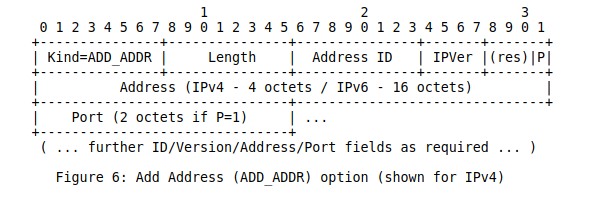
Then, the backup bit was removed in draft-ietf-mptcp-multiaddressed-03. In draft-ietf-mptcp-multiaddressed-04, a new option called MP_PRIO was introduced to allow a host to dynamically change the priority (backup or not) of an address. This separation between the address advertisement and the announcement of the backup status was intended to provide more reactivity.

This option is sent by a receiver to indicate to its peer that it wants to change the backup status of the subflow over which this option is sent.
It should be noted that the MP_JOIN option that is used to create subflows contains a backup flag that allows to indicate whether a new subflow should be treated as a backup one or not. In contrast with the MP_PRIO option that is sent unreliably in a TCP option, the MP_JOIN option is always exchanged reliably, which guarantees that the communicating hosts know the backup status of newly established flows.
The discussion on advertising addresses continued within the IETF after the publication of RFC 6824. The Linux implementation supports this option and uses it to announce a new address as soon as this address is known. However, the reception of an ADD_ADDR option does not necessarily trigger the establishment of a subflow. This is under the responsibility of the path manager. The fullmesh patch manager running on a client tries to use all possible addresses, but a Linux server does not create subflows. Apple’s implementation does not support the ADD_ADDR option. They assume that the servers have a single IP address and that the client will anyway create subflows by using the MP_JOIN option.
One of the concerns with the ADD_ADDR option included in RFC 6824 was the risk of attacks where an attacker could inject his address in an existing Multipath TCP connection by sending a spoofed packet containing this option and valid TCP sequence numbers. This attack was described in the threats analysis RFC 7430. The new ADD_ADDR option was proposed at IETF88 and included in draft-ietf-mptcp-rfc6824bis-00. It includes a truncated HMAC that authenticates it with the keys exchanged during the initial handshake. It also ensures that this option is not modified by an on-path attacker that has not observed the initial handshake.
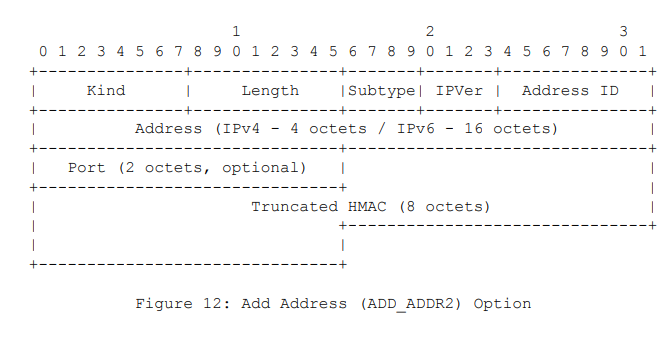
The discussion continued and draft-ietf-mptcp-rfc6824bis-01 introduced an Echo bit to provide a reliable delivery of this option.
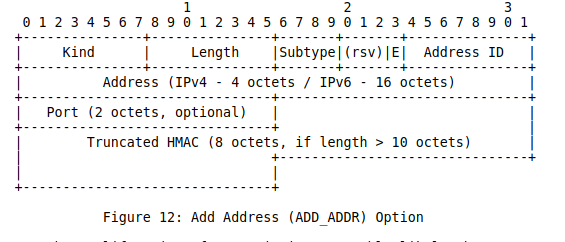
As of December 2018, this option is included in the last version of draft-ietf-mptcp-rfc6824bis-12 but has not yet been deployed in the field.
References
| [HTSB15] | Benjamin Hesmans, Viet-Hoang Tran, Ramin Sadre, and Olivier Bonaventure. A first look at real multipath tcp traffic. In Traffic Monitoring and Analysis. 2015. URL: https://inl.info.ucl.ac.be/publications/first-look-real-multipath-tcp-traffic.html. |
| [TCH+16] | Viet-Hoang Tran, Quentin De Coninck, Benjamin Hesmans, Ramin Sadre, and Olivier Bonaventure. Observing real multipath tcp traffic. Computer Communications, 2016. URL: https://inl.info.ucl.ac.be/publications/observing-real-multipath-tcp-traffic.html, doi:10.1016/j.comcom.2016.01.014. |